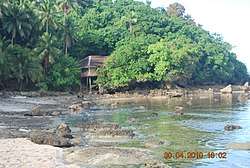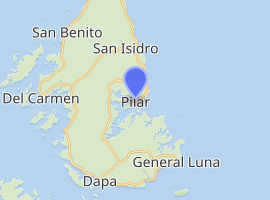Pilar, Surigao del Norte
Pilar, officially the Municipality of Pilar, is a 5th class municipality in the province of Surigao del Norte, Philippines. According to the 2015 census, it has a population of 9,752 people.[3]
Pilar | |
|---|---|
| Municipality of Pilar | |
 | |
 Seal | |
 Map of Surigao del Norte with Pilar highlighted | |

| |
.svg.png) Pilar Location within the Philippines | |
| Coordinates: 9°52′N 126°06′E | |
| Country | |
| Region | Caraga (Region XIII) |
| Province | Surigao del Norte |
| District | 1st District |
| Barangay | 15 (see Barangays) |
| Government | |
| • Type | Sangguniang Bayan |
| • Mayor | Maria Liza G. Resurreccion |
| • Vice Mayor | Edito E. Salvaloza |
| • Congressman | Francisco Jose F. Matugas II |
| • Electorate | 8,197 voters (2019) |
| Area | |
| • Total | 77.11 km2 (29.77 sq mi) |
| Elevation | 8.4 m (27.6 ft) |
| Population (2015 census)[3] | |
| • Total | 9,752 |
| • Density | 130/km2 (330/sq mi) |
| • Households | 2,353 |
| Economy | |
| • Income class | 5th municipal income class |
| • Poverty incidence | 36.8% (2015)[4] |
| • Revenue (₱) | 49,175,027.43 (2016) |
| Time zone | UTC+8 (PST) |
| ZIP code | 8420 |
| PSGC | |
| IDD : area code | +63 (0)86 |
| Climate type | tropical rainforest climate |
| Native languages | Surigaonon Agusan language Cebuano Tagalog |
It is located on Siargao Island, bounded by the Municipality of San Isidro to the north, Municipality of Del Carmen to the west, Municipality of Dapa to South and Philippine Sea to the east. It used to be a barrio of Dapa until its creation as a separate municipality on October 31, 1953 by virtue of Executive Order No. 638 issued by then President Elpidio Quirino.[5] Pilar has a natural harbor through a small inlet called Port Pilar.
Barangays
Pilar is politically subdivided into 15 barangays, listed here with 2010 populations.
Town Proper Barangays (Poblacion)
- Asinan - 937
- Centro - 343
- Pilaring - 851
- Punta - 381
Outlying Barangays
- Caridad - 1,456
- Consolacion - 200
- Datu - 570
- Dayaohay - 350
- Jaboy - 265
- Katipunan - 547
- Maasin - 1,001
- Mabini - 286
- Mabuhay - 455
- Salvacion - 772
- San Roque - 1,042
Demographics
| Population census of Pilar | |||||||||||||||||||||||||||||||||||||
|---|---|---|---|---|---|---|---|---|---|---|---|---|---|---|---|---|---|---|---|---|---|---|---|---|---|---|---|---|---|---|---|---|---|---|---|---|---|
|
| ||||||||||||||||||||||||||||||||||||
| Source: Philippine Statistics Authority[3][6][7][8] | |||||||||||||||||||||||||||||||||||||
Religion
Almost all inhabitant are Christians and majority follows Roman Catholicism. Pilar is a parish under the Roman Catholic Diocese of Surigao. The town got its name from its patron saint, Our Lady of the Pillar.
Language
Surigaonon is the local language. Cebuano, Filipino and English are also understood.
Climate
| Climate data for Pilar, Surigao del Norte | |||||||||||||
|---|---|---|---|---|---|---|---|---|---|---|---|---|---|
| Month | Jan | Feb | Mar | Apr | May | Jun | Jul | Aug | Sep | Oct | Nov | Dec | Year |
| Average high °C (°F) | 27 (81) |
27 (81) |
28 (82) |
29 (84) |
30 (86) |
29 (84) |
30 (86) |
30 (86) |
30 (86) |
29 (84) |
29 (84) |
28 (82) |
29 (84) |
| Average low °C (°F) | 23 (73) |
23 (73) |
23 (73) |
24 (75) |
24 (75) |
24 (75) |
24 (75) |
24 (75) |
24 (75) |
24 (75) |
24 (75) |
24 (75) |
24 (75) |
| Average precipitation mm (inches) | 161 (6.3) |
132 (5.2) |
112 (4.4) |
87 (3.4) |
136 (5.4) |
169 (6.7) |
146 (5.7) |
148 (5.8) |
132 (5.2) |
156 (6.1) |
176 (6.9) |
170 (6.7) |
1,725 (67.8) |
| Average rainy days | 20.0 | 16.2 | 18.3 | 17.5 | 24.0 | 26.7 | 27.5 | 27.5 | 26.5 | 26.4 | 23.8 | 21.1 | 275.5 |
| Source: Meteoblue [9] | |||||||||||||
Economy
The town's economy is largely based on fishing and agriculture. Major agricultural produce are rice and coconut (copra).
Tourism
Various homestay facilities are available in town for tourists.
Magpupungko Lagoons and Rock Formations

Magpupungko is the most popular tourist destination in Pilar. It is famous for its lagoons which can only be seen during low tide. It also features picturesque limestone rock formations.
Other Beaches and Rock Formations
Other areas that can be explored by tourists are Taglungnan Beach and Tagbayanga Islets, which are across town proper and can be reach in 15–20 minutes by boat ride. Other beaches are Lukod Beach and Caridad Beach.
Surfing
Pilar is also one of the surfing spots in Siargao and is less crowded. It is one and a half hour boat ride from General Luna, where the more popular surfing spot Cloud 9 is located. It holds many good lefts and is best surfed during NE swells. There are good breaks in front and near the town proper and in Barangay Caridad.[10]
Game Fishing
Pilar is popular to game fishing enthusiasts. The town hosts an annual invitational sport fishing event dubbed as Siargao International Game Fishing Tournament.[11]
Mangrove Forest
Pilar has an extensive mangrove forest reserve.
Philippine Freshwater Crocodile
Thirty-six Philippine freshwater crocodile (Crocodylus mindorensis) were released in Paghongawan Marsh (misspelled by media as Paghowangan) in Barangay Jaboy last March 2013 as part of conservation effort to bolster the population of this endangered reptile. The released crocodiles are all yearlings and were bred in captivity. The marsh extends 300 acres (120 hectares) in the dry season and more than 1,500 acres (600 hectares) in the wet season. These crocodiles are not endemic to Siargao and are smaller compared to saltwater crocodiles which can be found in the western side of Siargao, in the mangrove forest of Del Carmen town.[12]
Infrastructure
Transportation
Pilar is connected to Surigao City through the Port of Dapa. Jeepneys ply between Pilar and Dapa daily. It is connected to Cebu City and Metro Manila through Sayak Airport in the adjacent Municipality of Del Carmen. Habal-habal (motorcycle) can also be rented to service transportation needs.
Healthcare
Pilar has a district hospital but now mostly serve lying-in and maternity services. There is also a rural health center in the town proper.
Telecommunications
Globe Telecom and Smart Communications operate transmission towers in the town proper.
Education
Pilar is served by 2 high schools, Pilar National High School in the town proper and Pilar National High School - Caridad Annex in its biggest barangay, Caridad. There are also 12 elementary schools led by Pilar Central Elementary School.
References
- "Municipality". Quezon City, Philippines: Department of the Interior and Local Government. Retrieved 31 May 2013.
- "Province: Surigao del Norte". PSGC Interactive. Quezon City, Philippines: Philippine Statistics Authority. Retrieved 12 November 2016.
- Census of Population (2015). "Caraga". Total Population by Province, City, Municipality and Barangay. PSA. Retrieved 20 June 2016.
- "PSA releases the 2015 Municipal and City Level Poverty Estimates". Quezon City, Philippines. Retrieved 12 October 2019.
- "Pilar Historical Background". Archived from the original on May 20, 2014. Retrieved April 11, 2014.
- Census of Population and Housing (2010). "Caraga". Total Population by Province, City, Municipality and Barangay. NSO. Retrieved 29 June 2016.
- Censuses of Population (1903–2007). "Caraga". Table 1. Population Enumerated in Various Censuses by Province/Highly Urbanized City: 1903 to 2007. NSO.
- "Province of Surigao del Norte". Municipality Population Data. Local Water Utilities Administration Research Division. Retrieved 17 December 2016.
- "Pilar: Average Temperatures and Rainfall". Meteoblue. Retrieved 20 November 2019.
- "Pilar Siargao Surfing". Retrieved April 11, 2014.
- "PGMA opens 1st Siargao International Game Fishing". Retrieved April 11, 2014.
- "Philippine Freshwater Crocodile Introduction in Siargao". Retrieved April 11, 2014.
External links

- Pilar Profile at PhilAtlas.com